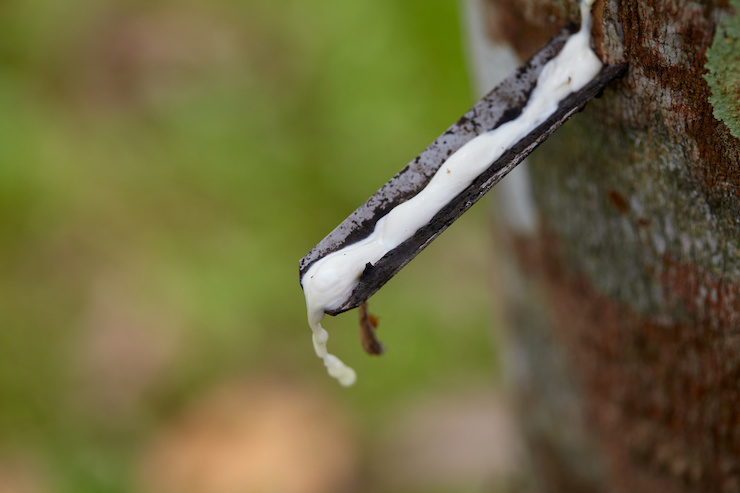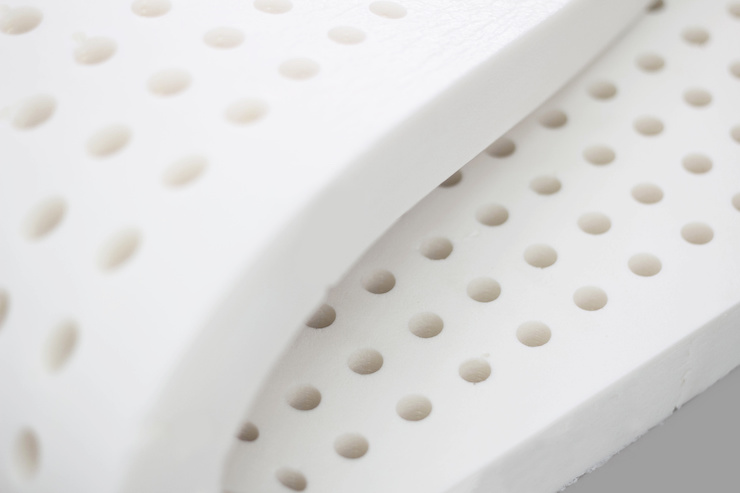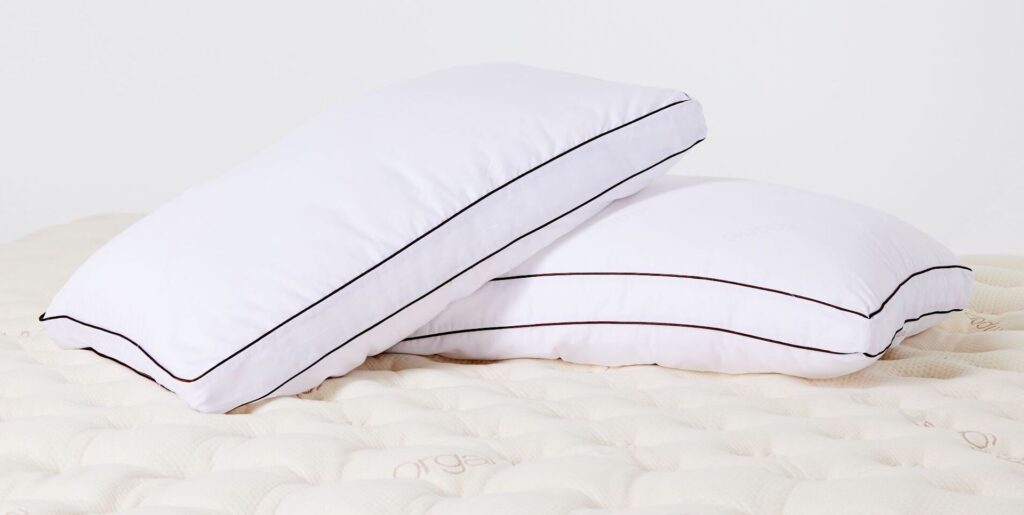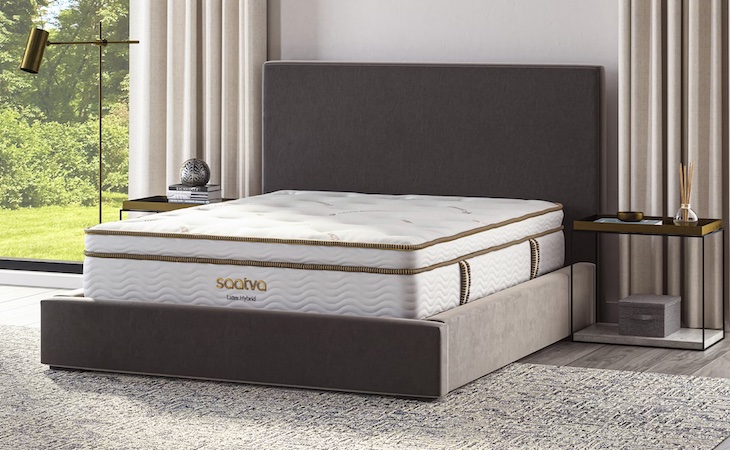
Mattress Types & Sizes, Mattresses
July 8, 2025
Natural vs. Synthetic Latex: What’s the Difference?
Written by Tanya Slavin

Natural latex, made from rubber tree sap, is breathable, hypoallergenic, and eco-friendly but comes at a higher cost. Synthetic latex, derived from petroleum, is more affordable and consistent in feel but less durable and less breathable. Choosing between them depends on budget, durability, allergies, and environmental preferences.
Latex mattresses have risen in popularity in recent years, and it’s easy to see why. Latex has the pressure-relieving properties of memory foam coupled with the buoyancy and coolness of innerspring.
However, not all latex foam is created equal. The key distinction to keep in mind is between natural latex vs. synthetic latex.
Understanding the differences between the two is crucial in making an informed choice for your specific needs. Which of the two is right for you? Keep reading to find out so you can pick the best latex mattress for you.

What is natural latex?
What it is
Natural latex is derived from the sap of a rubber tree. To make natural latex foam, the liquid sap of the rubber tree is sustainably harvested and sent to a production facility, where it’s mixed with a small amount of non-toxic, inorganic ingredients and whipped into an airy batter. After that, the airy mixture is poured into a mold and baked into a solid form.
There are two types of natural latex—Dunlop and Talalay—each providing a slightly different feel that results from two different methods of making latex foam.
Within the natural category is organic latex. This latex has been certified with an organic seal of approval. Learn more about the differences between natural vs. organic latex.
Key characteristics
Mattresses made of 100% natural latex are cushiony and responsive, providing excellent pressure relief properties. They’re extremely breathable, hypoallergenic, and antimicrobial and are suitable for all types of sleepers.
Pros
- Hypoallergenic: Natural latex is hypoallergenic and resistant to mold and dust mites, making it a good choice for anyone with allergies.
- Breathable: Due to the airy structure of the foam, natural latex is very breathable.
- Durable: Natural latex mattresses are extremely durable and may last for many years.
- Environmentally conscious: Natural latex is made from a renewable source (the sap of rubber trees) and is biodegradable, ensuring its environmental footprint is relatively low.
Cons
- Higher price point: It might be pricey because of the high harvesting cost.
- Variability in feel: Since it’s a natural product, there might be variability in firmness.
What is synthetic latex?
What it is
Synthetic latex is a type of foam that’s been engineered to resemble the properties of natural latex. Unlike natural latex, which is made from natural materials, synthetic latex is made from petroleum-derived compounds.
There are several types of synthetic latex, but the one that’s most commonly used in the production of synthetic latex foam is SBR (styrene-butadiene rubber).
Key characteristics
Since synthetic latex foam is produced in an industrial setting, it’s easier to control its physical properties, such as firmness and density. Therefore, it might offer a more consistent feel than natural latex.
However, being a petroleum-derived product, it has a higher environmental footprint than natural latex and can’t rival its breathability. Synthetic latex foam might also be less springy than natural latex foam.
Pros
- Cost-effective: Synthetic latex is less costly to produce than natural latex.
- Uniform firmness: Since it’s produced in a controlled setting, it might offer a more predictable and uniform firmness level than natural latex.
- Great for people with latex allergy: Synthetic latex is a great alternative for people with latex allergy.
Cons
- Not as bouncy: Although synthetic latex has been designed to mimic the properties of natural latex, it can’t quite rival the natural springiness of the real thing.
- Less durable: Synthetic latex tears more easily and may wear out faster than natural latex.
- Higher environmental footprint: Being a petroleum-based product, synthetic latex mattresses have a higher environmental footprint than natural latex.
- Chemical smell: Some synthetic mattresses emit a strong chemical smell, which might be problematic for people with sensitivities to these chemicals.

Natural vs. synthetic latex: Which one is better?
Now that you know the difference between synthetic latex vs. natural latex, how do you decide which one to choose?
Clearly, natural latex is better both for your health (in most cases) and for the environment—but beyond this obvious point, here are a few key points to consider before you make your choice.
Cost effectiveness
Due to the high cost of harvesting the material, natural latex is typically more expensive than synthetic latex. If you have set your heart on a latex mattress but are on a tight budget, synthetic latex could be an excellent alternative.
Durability and longevity
Synthetic latex foam tears more easily than natural latex and may wear out sooner. A natural latex mattress may last as long as 15 to 20 years, making it a great long-term investment.
Allergies and sensitivities
Due to its airy and breathable structure, which prevents heat retention and moisture buildup, natural latex is naturally hypoallergenic, making it the ideal choice for allergy sufferers.
Synthetic latex might not have the breathability of natural latex, leading to moisture buildup. Additionally, it might not be suitable for people who are sensitive to the chemicals used in the production of synthetic latex.
On the other hand, synthetic latex is an excellent alternative for people who have a latex allergy and want to sleep on this type of mattress.
Comfort and performance
Generally, although natural and synthetic latex have a similar feel, synthetic latex might be less springy than natural latex. But on the flip side, synthetic latex might offer a more uniform firmness and feel, which might be an important factor for some people. In the end, it really comes down to personal preference.
FAQs
What are the disadvantages of synthetic latex?
Synthetic latex is produced from petroleum-based products, so it’s less environmentally conscious than natural latex. It also lacks the breathability and longevity of natural latex.
Is a synthetic latex mattress good?
Synthetic latex has been engineered to closely mimic the qualities of natural latex. It’s less breathable and less durable than natural latex, but it’s a cost-effective alternative if you’re on a tight budget.
Is natural latex OK for a latex allergy?
No. Natural latex isn’t safe for those who suffer from a latex allergy. People with a latex allergy have an allergic reaction to proteins found in natural latex and generally shouldn’t use products made from this material.
Find the best latex mattress for you at Saatva
If you’re ready to purchase a latex mattress, we offer two excellent options: Zenhaven and Saatva Latex Hybrid. Both are made with natural latex for buoyant, pressure-relieving comfort and come with a 365-night home trial, free in-home delivery and setup, and a lifetime warranty.
Tanya Slavin
Tanya Slavin is a freelance writer with a PhD in Linguistics. When she has had enough sleep, she learns languages and writes about it in her newsletter Friends with Words which documents her journey to learn 12 languages in 12 months.






